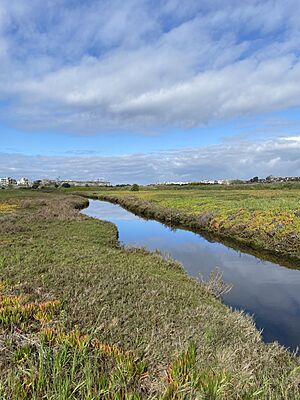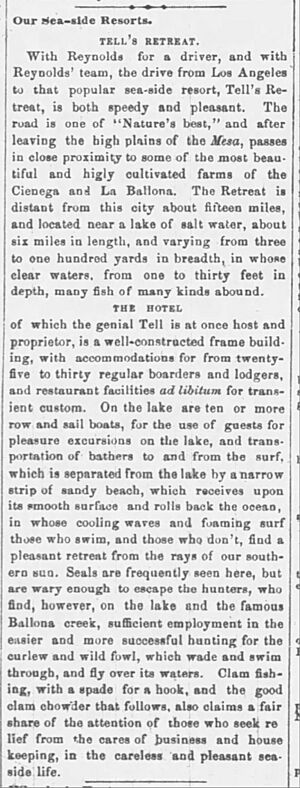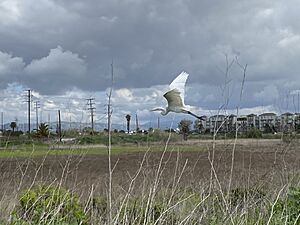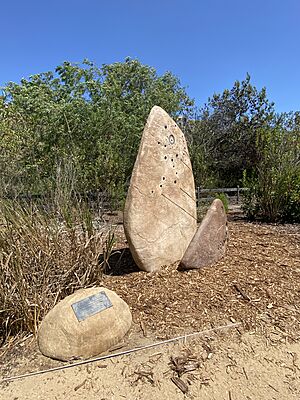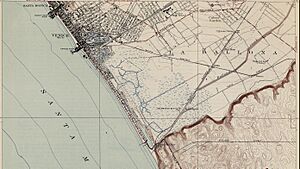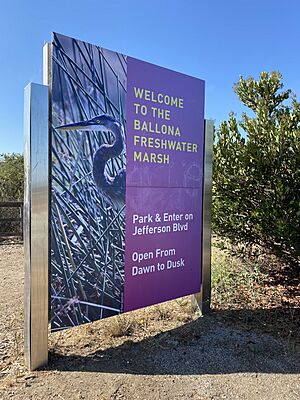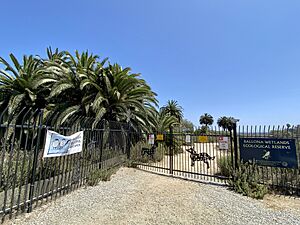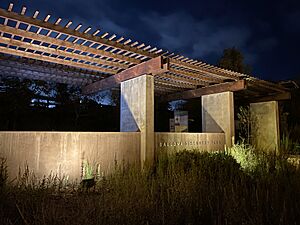Ballona Wetlands facts for kids
Quick facts for kids Ballona Wetlands Ecological Reserve |
|
|---|---|
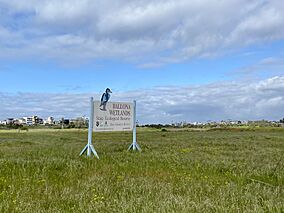 |
|
| Location | Los Angeles County, California, United States |
| Area | 577 acres (234 ha) |
| Operator | California Department of Fish and Wildlife |
The Ballona Wetlands Ecological Reserve (say "Bah-yo-nuh" or "Buy-yo-nah") is a special protected area in Los Angeles County, California. It used to be a natural estuary, which is where a river meets the sea, for the nearby Ballona Creek. This important site covers about 577 acres (2.3 km²) and is located just south of Marina del Rey.
Ballona is the second-largest open space in Los Angeles, after Griffith Park. The state of California owns it, and the California Department of Fish and Wildlife manages it. The reserve is split by the Ballona Creek channel and has the 90 Marina Freeway to its east.
The Ballona Wetlands Ecological Reserve is one of the last big wetlands left in Los Angeles County. Wetlands are areas that are often flooded and have special plants. Ballona is a delicate, natural marsh fed by both fresh and salt water. Many wetlands in the Los Angeles area have been filled in for buildings. Wetlands are full of life and are some of the most productive places on Earth.
Contents
Exploring Ballona's Geography
The Ballona Wetlands were once much larger, possibly between 1,500 and 2,100 acres (6.1 to 8.5 km²). Today, the wetlands have five main natural areas:
- Saltwater marsh: This part is fed by ocean water.
- Freshwater marsh: This part gets its water from creeks and streams.
- Riparian corridor: This is the area along the creek.
- Sand dunes: Hills made of sand.
- Bluffs: Steep cliffs.
The wetlands are home to different types of habitats. These include coastal grasslands, willow forests, shrublands, and areas with salty pools. There are also temporary pools that fill with water after rain.
The Ballona Creek acts as a flood control channel. In the late 1950s, the Marina del Rey harbor was built, which added more urbanized estuary space.
Land east of the wetlands was used for farming in the early 1900s. Many of these farms became the private Hughes Airport. Other fields were farmed until the 1990s. In the 2000s, the Hughes Airport land was developed into Playa Vista, a neighborhood east of Lincoln Boulevard.
Who Owns the Land?
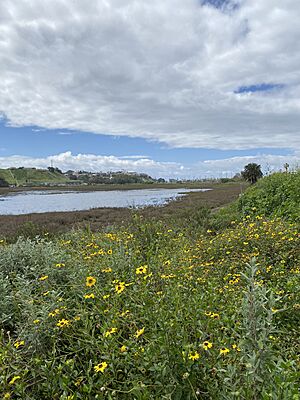
The remaining open space of the old Rancho la Ballona has been the subject of long-running debates. Developers wanted to build on it, while environmental groups wanted to protect it.
About 83 acres (33.6 hectares) of the wetland were bought by the state. This land was once owned by Howard Hughes and later by developers of Playa Vista. Many environmental lawsuits and the state's purchase of land have helped protect almost all the open space west of Lincoln Boulevard. This includes all the remaining tidal wetlands.
The Southern California Gas Company has a facility in one part of the wetlands (Area B). Oil drilling happened here in the 1900s, and some old equipment is still there.
Ballona Freshwater Marsh
The Ballona Freshwater Marsh (BFM) is a 26.1-acre (10.6-hectare) marsh. It gets its water from Bluff Creek, which is a leftover part of Centinela Creek. This marsh was built in 2003 by the company that developed the nearby Playa Vista neighborhood.
Before it was a marsh, the land was an old celery field. About 50 bird species lived there. Creating the Freshwater Marsh has been very successful. It now provides a rich natural home for plants and animals, and people can visit it. About 250 different bird species have been seen at the Freshwater Marsh.
How the Wetlands are Divided

For planning and study, the Ballona Wetlands are usually split into four sections:
- Area A: West of Lincoln Boulevard, north of the creek.
- Area B: West of Lincoln, south of the creek.
- Area C: East of Lincoln, north of the creek, west of the Marina Freeway.
- Area D: The Playa Vista neighborhood, including the Bluff Creek area.
Wildlife and Plants of Ballona
Wetlands are important for many reasons. They are not just for birds. They also act as nurseries for fish, filter water and air, help refill underground water sources, and protect homes from floods.
Plants of the Wetlands
Some of the native plants found in the wetlands include pickleweed, alkali heath, saltgrass, and glasswort. Upland areas have plants like coyote bush and goldenbush.
Some common plants that were brought to the wetlands from other places include crown daisy, Canary Island palm, ice plant, pampas grass, and wild mustard.
Volunteers from the Friends of Ballona Wetlands have helped restore eight acres (3.2 hectares) of sand dune habitat.
A rare native plant called Orcutt's yellow pincushion (Chaenactis glabriuscula var. orcuttiana) was found at Ballona in 2010. This plant only grows in the coastal dunes of Southern California.
Animals of the Wetlands
Ballona is recognized as an Important Birding Area by the Audubon Society. Almost 260 bird species from nearly 50 different bird families have been seen at the Ballona freshwater marsh alone. If you include the wetlands, nearby bluffs, parks, and neighborhoods, the total bird count for the area is 320 species!
The Ballona Wetlands and nearby lagoons are a resting stop along the Pacific Flyway. This is a major path that birds use to migrate (travel) between North and South America. Migratory birds stop in wetlands to rest and find food. Saltwater flooding provides a lot of food for both shorebirds and land birds. About 90% of wetlands in Los Angeles County have been destroyed. This means there are fewer "stepping stones" for birds along the Pacific Flyway.
Bird watchers often see red-throated loons, herons, tree swallows, barn swallows, hummingbirds, and red-tailed hawks at the marsh. The green heron, great blue heron, and snowy egret are also common. These shorebirds eat clams, snails, crabs, worms, and shrimp.
Sometimes, birds not usually seen in the area visit Ballona. These can include surfbirds, wandering tattlers, black oystercatchers, pelicans, scoters, loons, and grebes. You might even spot a harlequin duck or different types of warblers. The mud flats are home to golden plovers, white-tailed kites, and short-eared owls. More common birds at the water's edge include plovers, willets, sanderlings, curlews, and killdeer.
Special bird species seen here include nesting pairs of Belding's Savannah sparrow and California least terns looking for food.
The wetlands and waterways are home to many types of dragonfly and damselflies. Five kinds of bumblebees, including Crotch's bumblebee (which needs special protection), have been found here. Several reptile species live here, such as the San Diego legless lizard and a group of Southern Pacific rattlesnakes. In the 1990s, a group of red foxes that had been introduced were moved away. Now, coyotes are often seen in the wetlands and nearby areas.
A Look Back at Ballona's History
During digs at the Playa Vista site, tools and ancient human remains from the Tongva were found. For the remaining Tongva people, the Ballona Wetlands are a sacred place. They lived near the wetlands, ate fish from its waters, and hunted rabbits. They used plants like pickleweed for medicine and buried their dead there.
The name "Ballona" has a debated origin.
In 1911, a California newspaper shared some history about the area: The ocean front of La Ballona Rancho was known as "Ballona Slough." It was a marshy area with sand dunes and saltwater lagoons, thought to be only good for ducks and other game birds. In 1870, a man named William Tell built a small house there and called it Tell's Lookout. He offered boats, guns, and fishing gear to visitors. In 1877, Michael Duffy opened "Hunter's Cottage" in the same spot, offering food and hunting supplies.
An "old-timer" who remembered the area from 1876 to 1890 said there were few trees. From the hills, you could see the ocean waves over the sand dunes at Playa Del Rey, which was then called William Tell's Lake.
A history of Santa Monica mentioned that duck hunting and boating on the Ballona laguna were popular. Spanish games were held in the spring when a channel was dug to let water flow from the laguna into the ocean at what is now Playa del Rey.
In 1887, the wetlands were important because of plans for Port Ballona. The "great marsh of Ballona" was seen as a resource for people living in Santa Monica. People collected seaweeds to press into designs and sold them to tourists. Birds like egrets, herons, and ibises were used to make screens and fans. The marsh was also full of game, including wild ducks.
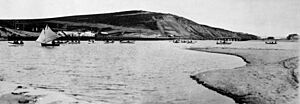
Hunting was popular here until at least 1910, especially for green-winged teal ducks. By 1921, Ballona Creek ended about a mile from the ocean, with the wetlands absorbing much of the water.
In 1940, Howard Hughes bought land near the Westchester bluffs for his airport. In 1976, a resident described the wetland as a place where field mice, jackrabbits, and many birds roamed freely, despite "No trespassing" signs. She was amazed that birds could find such a wild place in the middle of Los Angeles.
Around 1979, the salt marshes were part of a big disagreement between developers and environmentalists. Schoolgirls rode horses there, and children learned about nature.
In 1995, as the Playa Vista development was starting, the L.A. Times explained Ballona's 20th-century history. It said the Ballona Wetlands were almost all that was left of 1,800 acres of marsh. Building Ballona Creek in the 1930s and Marina del Rey in the 1960s greatly changed the wetlands.
Restoring the Wetlands
A big plan to restore the Ballona Reserve started in 2004. In December 2020, the California Department of Fish and Wildlife approved the final environmental report for the Ballona Wetlands Restoration Project. However, in May 2023, a court ordered that report to be canceled. The Department officially canceled it in September 2023. There is no current timeline for a new plan.
The proposed restoration project aims to increase coastal wetlands by about 200 acres (0.8 km²). It also plans to change the Ballona Creek levees (walls) to allow for sea-level rise. The creek channel would be made more natural, with a winding shape, to improve how ocean tides flow into the reserve.
The restoration plan also includes new features for visitors. These include two new bridges, a scenic viewing deck, 3.6 miles (5.8 km) of bike and walking trails, 5.5 miles (8.9 km) of walking-only paths, 2,000 feet (610 m) of boardwalk, educational signs, and more parking.
Under the plan, SoCalGas would close 16 old oil wells and remove related roads and buildings. Six new wells would be installed to monitor the area.
There is still disagreement about the Ballona restoration projects. Jon Christensen, a professor at UCLA, said in 2020 that Ballona shows two different ways people think about nature. One idea is that we have interfered enough and should leave nature alone. The other idea is that humans are powerful and should use their knowledge to restore nature.
Groups that support the plan include the California Department of Fish and Wildlife, Friends of the Ballona Wetlands, Heal the Bay, the Bay Foundation, SoCal Gas, and SoCal Edison. Groups that are against it include the Los Angeles Audubon Society, Grassroots Coalition, and Ballona Wetlands Land Trust.
Visiting Ballona Wetlands
Even though two major roads are next to the wetlands, it's still worth visiting. You can imagine what the area was like in the past and what it could become.
One visitor to the freshwater marsh noted that even with traffic noise, just a few feet away is a different world full of plants, wildlife, and bird songs.
You can see parts of the Ballona Wetlands Ecological Reserve from the Ballona Creek Bike Path.
- Ballona Freshwater Marsh
You can visit the Ballona Freshwater Marsh during daylight hours. There's a 0.75-mile (1.2 km) walking path along Jefferson and Lincoln Boulevards. Parking is sometimes available along Jefferson, but these spots are often taken. More parking can be found near Ballona Discovery Park in Playa Vista. You can also get there by Big Blue Bus line 3 and ![]() Metro bus line 115.
Metro bus line 115.
- Ballona Saltwater Marsh
The Ballona Saltwater Marsh is closed to the public. However, the Friends of Ballona Wetlands offer regular guided tours, and the Audubon Society hosts monthly bird walks. These tours start from an entrance in Playa Del Rey.
Tours often stop at a viewing deck built on an old Pacific Electric Red Car train track.
![]() Metro bus route 115 serves this area. Limited parking is available behind Gordon's Market.
Metro bus route 115 serves this area. Limited parking is available behind Gordon's Market.
- Area A
Area A can be reached from Fiji Way, across from Fisherman's Village in Marina Del Rey, or from an entrance along the Ballona Creek Bike Path. Area A is open from 8 a.m. to 1 p.m., Wednesday through Saturday. Culver CityBus route 7 serves this location. There is a dedicated parking lot for cars, and bike racks are available along the bike path.
- Ballona Discovery Park
Ballona Discovery Park is not part of the state-owned reserve, but it's right across the street, next to Bluff Creek, in the Playa Vista area. It opened in 2011 as an outdoor museum. Native plants and bird feeders attract wildlife. A model kiiy (a traditional Tongva house) and signs teach visitors about the Tongva native people. The park's address is 13110 Bluff Creek Drive, Playa Vista 90094.
More to Explore
- Redondo Beach via Playa del Rey Line, an old train route through the Wetlands
- Venice–Inglewood Line, another old train route through the Wetlands
- Friends of Ballona Wetlands, a group that works to protect the wetlands
Other Wetlands in Southern California
- Madrona Marsh
- Gardena Willows Wetland Preserve
- Bixby Marshland
- Los Cerritos Wetlands
- Bolsa Chica State Ecological Reserve
- Tijuana Slough National Wildlife Refuge
Nearby Nature Spots and Neighborhoods
- Del Rey Lagoon and Ballona Lagoon
- Dockweiler Beach
- Oxford Lagoon
- Venice Canals


